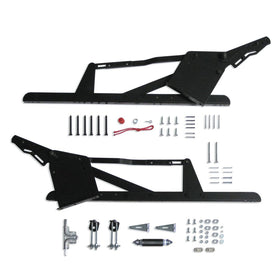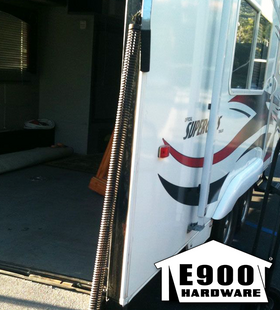Safety Procedures
It is recommended that both jamb type hardware and jamb type hardware with track be mounted on wood door jambs which comply with the following minimum specifications:
- National Forest Products Association, National Design Standards Table 8.1A, Group II or better material (ie. Douglas Fir)
- Minimum Specific Gravity of 0.51 (32 lb. per cubic ft.)
- Minimum Dressed Size of 1-1/2" x 5-1/2". If the door jambs are not made from wood, follow the manufacturers recommendations for jamb materials.
Garage door springs must be equipped with a device capable of restraining the spring (or spring pieces) in the event that it breaks. Usually the springs will include an integral containment device. In the event a spring is not equipped with a containment device, replace the spring with one that is properly equipped.
Garage door extension springs are designed for a minimum cycle life of 9,000 cycles. (One cycle is equal to one door opening and one door closure.)
Repair/Replace Tips
When replacing hardware, it is very important to inspect the jambs for damage such as splits, cracks, termite damage, dry rot, or excessive numbers of drilled holes. The integrity of the jambs is of utmost importance, because the weight of the door and the force of the springs are both acting on the lag screws that secure the master plate to the jamb. It is never acceptable to mount a new set of hardware using existing lag screw holes unless at least one of the following is done:
- Plug the existing holes using glue and wooden dowels.
- Drill through the entire jamb and bolt the hardware in place using grade 5 bolts and nuts.
- Add a steel support from the master plate up to the jamb.
- Replace existing jambs with new jambs.
*Refer to V-a for minimum jamb specifications. Refer to manufacturers instructions for hardware replacement.
When replacing a broken spring, a minimum of one spring per side should be replaced to maintain even balancing. Springs tend to lose tension after years of operation. The best practice is to replace all springs if they are more than five years old. Refer to manufacturer's instructions for spring replacement.
Truss Rod Kits
Used for wood garage doors exceeding 10' in width to prevent door from sagging in the open position. Rods are typically mounted to the top and bottom rails of the door. Over an extended period of time, a door may tend to sag, in which case the truss rods may require tightening. Refer to manufacturers instructions for installation and adjustment of truss rods.
Slide Bolt Lock
For locking the garage door with a padlock. Typically, the slide bolt is mounted 2 to 3 feet from the floor. A slide bolt may be used on each side of the door if desired.
Center Lock
An alternative to a slide bolt lock that is operated from the center of the door and can provide locking on both ends of the door. Some center locks may also be operated from the inside of the garage.
Rubber Bumpers
To prevent damage to the face of the door as it opens against the header. Bumpers are typically mounted to both ends of the header. Extra decorations on the face of the door must be considered when mounting the rubber bumpers. Bumpers can either be positioned to engage the thickest decorations, or they can be shimmed accordingly so that the decorations do not interfere with the header.
Lift Handle
For manual operation of the door. Typically, door handles are mounted 18" to 24" from the floor.
Weatherstrip
Mounted to the bottom and sides of the door to close the air gap around the door. Typically, weatherstrip is mounted to the sides of the door below the level of the master plate, and it is mounted to the door jambs above the level of the master plate. Refer to manufacturers installation instructions.
Product Maintenance
All points should be lubricated monthly.
Garage doors should be inspected periodically for proper balance. If the door is electrically operated, the operator should be disconnected per the manufacturer's instructions before testing or adjusting the balance of the door. Springs must be adjusted with the door securely propped in the open position.
- If the door is hard to pull down or goes up too fast in its upper 3/4 of travel, move the kicker up one hole at a time (both sides) in the master arm until door is balanced.
- If the door comes down too fast or is hard to lift up in its upper 3/4 of travel, the kicker must be moved down one hole at a time (both sides) in the master arm until the door is balanced.
- In the lower quarter of travel, the kicker can be adjusted as described in Section X,e.
- It is the best practice to adjust the springs in the same manner on both sides of the door.
The hardware and the door should be inspected regularly for signs for excessive wear, rubbing or binding which can be an indication of damaged or maladjusted hardware.


